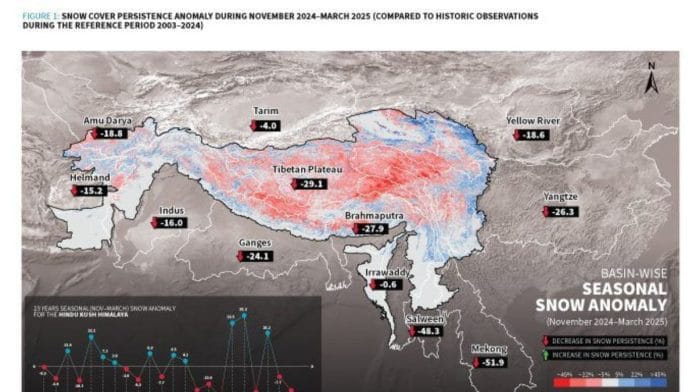New Delhi: In a concerning development, the Ganga Basin has recorded its lowest level of snow persistence in 23 years, according to a new report by the International Centre for Integrated Mountain Development (ICIMOD). Highlighting a worrying pattern of diminishing snowfall, the report also revealed that this marks the third consecutive year in which the Hindu Kush Himalaya (HKH) region has experienced below-normal snowfall.
The HKH Snow Update 2025, released Monday by the Nepal-based ICIMOD, stated that the Ganga Basin had previously recorded its highest snow persistence at approximately 30.2 percent in 2015, but this figure has now plummeted to a 23-year low of -24.1 percent in 2025.
The report cautioned that this ongoing decline in snowfall is likely to result in reduced water flow during the summer months.
The Hindu Kush—an 800-kilometre-long mountain range located in Central and South Asia to the west of the Himalayas—stretches across eastern and central Afghanistan into north-western Pakistan and far south-eastern Tajikistan. This vast region spans approximately 3,500 kilometres, encompassing India, Afghanistan, Pakistan, Bhutan, Bangladesh, China, Nepal and Myanmar, and serves as the source for nearly ten major Asian river systems.
“This trend, now in its third consecutive year, threatens water security for nearly two billion people. All twelve major river basins, including the Indus, Ganges, and Brahmaputra, experienced below-average snow cover, with the Mekong and Salween basins losing over 50%,” the report stated.
Also Read: 47 yrs ago, this Indian-origin physicist asked Feynman a question. He hasn’t looked back since
Alarming findings
The most striking declines in snow persistence were observed in the Mekong basin (-51.9%) and the Salween basin (-48.3%), followed closely by the Tibetan Plateau (-29.1%), the Brahmaputra basin (-27.9%), the Yangtze basin (-26.3%), and the Ganges basin (-24.1%).
The report, which analysed a 23-year time series (2003–2025) of basin-scale snow persistence during the snow season (November to March), identified recurring seasonal deficits alongside annual fluctuations in snowfall across the region.
What is particularly alarming is that these shortfalls have shown a marked increase each year, with a notable intensification over the past five years.
“The report warns of potential lower river flows, increased groundwater reliance, and heightened drought risk, urging improved water management, stronger drought preparedness, better early warning systems, and regional cooperation,” the document stated.
In the Indus Basin, snow persistence declined from +19.5 percent in 2020 to -24.5 percent in 2024, marking its lowest level in two decades. The trend persisted in 2025, with the basin recording a snow persistence anomaly of -16 percent.
“This sustained deficit threatens early summer water supply for nearly 300 million people,” the report warned.
Likewise, in the Brahmaputra Basin, snow persistence had reached a peak of +27.7 percent in 2019, but has steadily deteriorated, falling to -27.9 percent by 2025.
Solutions
ICIMOD has recommended that the continuing decline in seasonal snow persistence and snowmelt anomalies across the HKH river basins demands urgent and targeted action at the basin level.
The organisation stressed the importance of government investment in adaptive infrastructure, including seasonal water storage systems to maximise the utility of meltwater, and the formulation of strategies to address potential drought conditions in the future.
Countries must also prioritise the integration of snow anomaly data into national water management policies, particularly in sectors such as hydropower, agriculture, and allied industries. Furthermore, ICIMOD emphasised the necessity of establishing a comprehensive, standardised snow anomaly data collection framework, to aid national policy formulation and enhance inter-sectoral coordination.
(Edited by Radifah Kabir)
Also Read: Search for an Indian Carl Sagan is on. Science influencers are being trained in labs and likes






